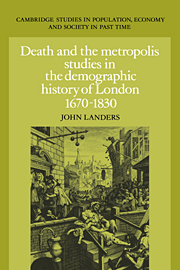Book contents
- Frontmatter
- Contents
- List of figures and maps
- List of tables
- Preface
- Acknowledgements
- Part I EIGHTEENTH-CENTURY LONDON AND ITS VITAL REGIME
- 1 Mortality theory and historical epidemiology
- 2 Aspects of metropolitan economic and social life
- 3 The ‘high potential’ model: a preliminary test
- Part II THE LEVEL OF MORTALITY
- Part III DIMENSIONS OF LONDON'S EPIDEMIOLOGICAL REGIME
- Appendices
- Bibliography
- Index
- Cambridge Studies in Population Economy and Society in Past Time
3 - The ‘high potential’ model: a preliminary test
Published online by Cambridge University Press: 05 November 2011
- Frontmatter
- Contents
- List of figures and maps
- List of tables
- Preface
- Acknowledgements
- Part I EIGHTEENTH-CENTURY LONDON AND ITS VITAL REGIME
- 1 Mortality theory and historical epidemiology
- 2 Aspects of metropolitan economic and social life
- 3 The ‘high potential’ model: a preliminary test
- Part II THE LEVEL OF MORTALITY
- Part III DIMENSIONS OF LONDON'S EPIDEMIOLOGICAL REGIME
- Appendices
- Bibliography
- Index
- Cambridge Studies in Population Economy and Society in Past Time
Summary
For much of the eighteenth century the relative movements of baptisms and burials in the London Bills of Mortality sketch the outlines of a grim picture, and one need not be a demographic determinist to share Dorothy George's sense of a metropolis dominated by the waste and destruction of lives which they imply. But London was not the only city in early modern Europe to display consistent burial surpluses, and in chapter 1 we considered a general model – put forward by W. H. McNeill – which attempts to explain the phenomenon in terms of the maintenance of endemic foci of infection. These result from a set of structural characteristics endowing such centres with what we have termed a ‘high exposure potential’ – characteristics which eighteenth-century London seems to have possessed in an exaggerated form. In this chapter we shall try to specify our model further and to make a preliminary test of its predictions against some aggregate vital data.
The high potential model of metropolitan mortality
For McNeill the large dense populations of metropolitan centres enabled immunising infections to persist, whilst their frequent contacts with the outside world promoted a two way traffic in pathogens between them, their relatively thinly settled hinterland, and the more remote places with which they maintained trading connections. They were thus characterised by high levels of conduction and retention, and by weak bounding, all of which contributed to a high exposure potential.
- Type
- Chapter
- Information
- Death and the MetropolisStudies in the Demographic History of London, 1670–1830, pp. 89 - 126Publisher: Cambridge University PressPrint publication year: 1993



